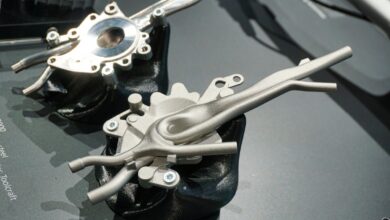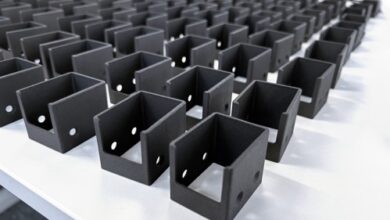
EOS Innovation Center in Düsseldorf
EOS heeft in Düsseldorf het eerste EOS Innovation Center in Europa geopend. Van hieruit gaat EOS de industrie in onder andere de Benelux ondersteunen in applicatie ontwikkeling voor AM en het opschalen van de productie. In het EOS Innovation Center staat het volledige AM proces ter beschikking van de klanten, zowel voor metaal als kunststoffen.
EOS ondersteunt klanten in AM applicatie ontwikkeling en opschalen productie
Na de VS, Singapore en Japan is nu Europa aan de beurt voor de vestiging van EOS Innovation Centers. Deze spelen een belangrijke rol in het verbreden van de toepassing van 3D printtechnologie, aldus EOS CEO Adrian Keppler bij de opening van het nieuwe AM centrum. EOS heeft weliswaar ondertussen 3000 systemen in het veld, veel bedrijven hikken nog tegen 3D printen aan omdat ze de meerwaarde ervan onvoldoende zien. “Daarom delen wij onze ervaringen zodat de leercurve van klanten versnelt”, zei Keppler bij de officiële opening. Het centrum werkt nauw samen met Additive Minds, de consultancytak van EOS.

Lokaal vakkennis opbouwen
Het idee komt oorspronkelijk van Bernd Reinarz, thans teammanager in het Innovation Center in Düsseldorf. “Ik zie in de praktijk dat vakmensen in de bedrijven de snelle ontwikkelingen op AM vlak niet kunnen bijbenen. Daarom heb ik EOS het idee voorgelegd om ze in dit soort centra te ondersteunen. EOS heeft dit opgepakt.” Hij vindt het belangrijk dat lokaal in de maakindustrie kennis over 3D printen wordt opgebouwd. Dat geldt zowel voor de bedrijven die nog blanco zijn op dit vlak alsook de bedrijven die bijvoorbeeld met validatie van AM processen bezig zijn. Beide groepen zijn welkom in het EOS Innovation Center Düsseldorf. Het Innovation Center kan ook gebruikt worden om de productie op de 3D printer van de klant te ontwikkelen inclusief de parameters. Dat gebeurt dan op de machine van de klant die eerst in Düsseldorf wordt geplaatst en daarna pas bij de klant.
3D printers en testapparatuur
In Düsseldorf staat een complete AM infrastructuur ter beschikking. Maar wat vooral telt, is de beschikbaarheid van engineers en AM experts die de klanten van EOS ondersteunen in de applicatie ontwikkeling. Dit zijn kleine teams die agile werken. Binnen enkele weken kunnen ze samen met de klant een applicatie voor 3D printen ontwikkelen en de eerste teststukken produceren. De applicaties worden geproduceerd en getest worden op de apparatuur die in het innovatiecentrum beschikbaar is. Naast twee M290 3D metaalprinters is dat ook een EOS P 396 lasersintermachine voor het 3D printen in kunststoffen en een compleet ingerichte testruimte. Hier staat onder andere een meetsysteem van Alicona Infinite SL. Hiermee kunnen de oppervlakken optisch in 3D worden gemeten.

Jeroen Bender (links) samen met Henny ten Pas in het nieuwe EOS Innovation Center in Düsseldorf.
Dichtbij voor de Benelux maakindustrie
Jeroen Bender en Henny ten Pas van Bender AM zijn blij met de keuze voor Düsseldorf als vestigingsplek. Juist voor de industrie in de Benelux en zeker voor de high tech en medische industrie in het Oosten en Zuiden van Nederland, betekent dit dat dichtbij een complete infrastructuur beschikbaar is voor bedrijven. Ze kunnen hier toepassingen voor 3D printen gaan ontwikkelen. “Dit EOS Innovation Center verlaagt de drempel voor de industrie om met 3D printen te starten enorm. Voor Nederland is dit een ideale locatie”, zegt Jeroen Bender.
Komende week staat Bender AM met een EOS M290 metaalprinter op de TechniShow in Utrecht
FOTO: teamleider Bernd Reinarz knipt officieel het lint door, vastgehouden door EOS CEO Adrian Keppler (rechts) en Daniel Adler, (Wirtschaftsförderungsamt, Landeshauptstadt Düsseldorf)
![]()
Het meetsysteem van Alicona om de oppervlakteruwheden in 3D te meten.

Een toepassing van Aidro uit Italië; een 3D geprint hydraulisch ventielblok.






